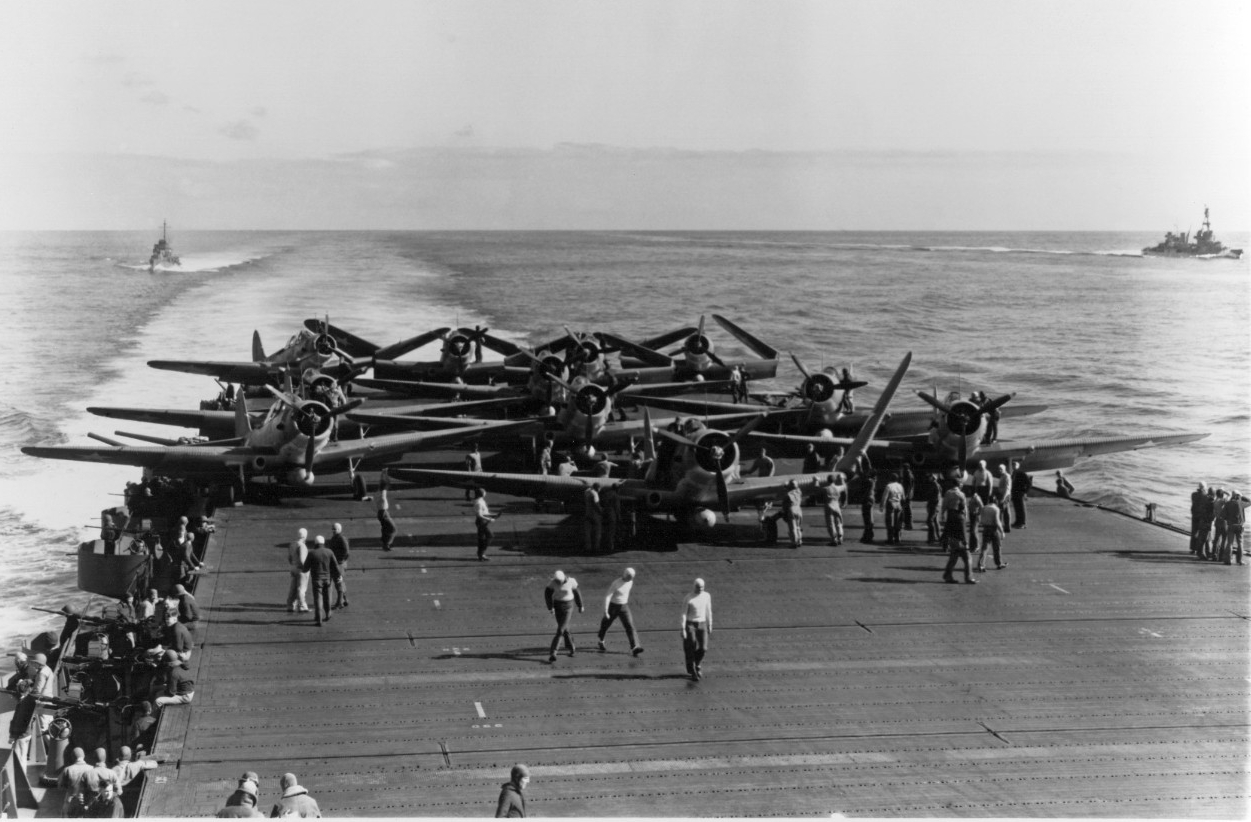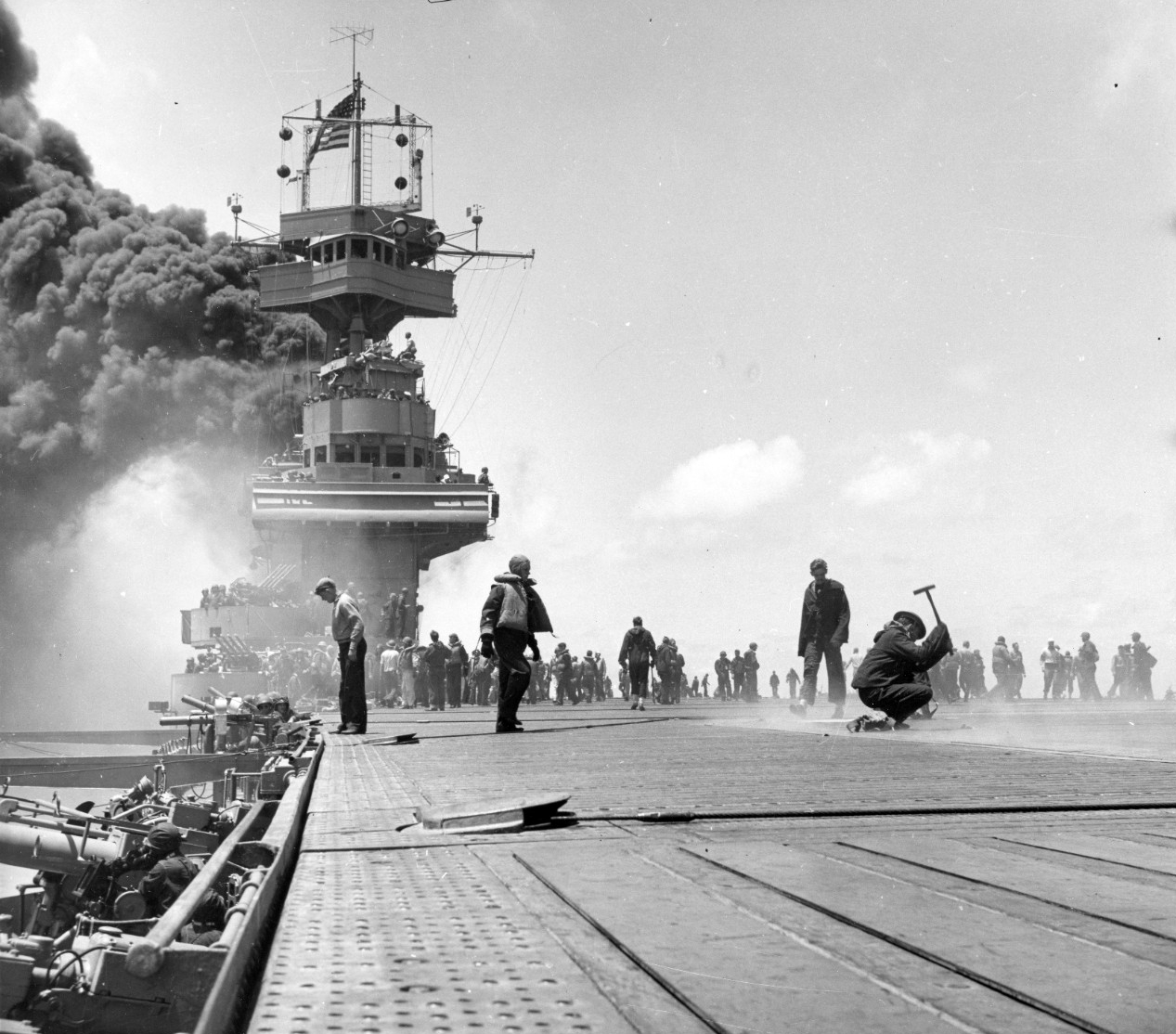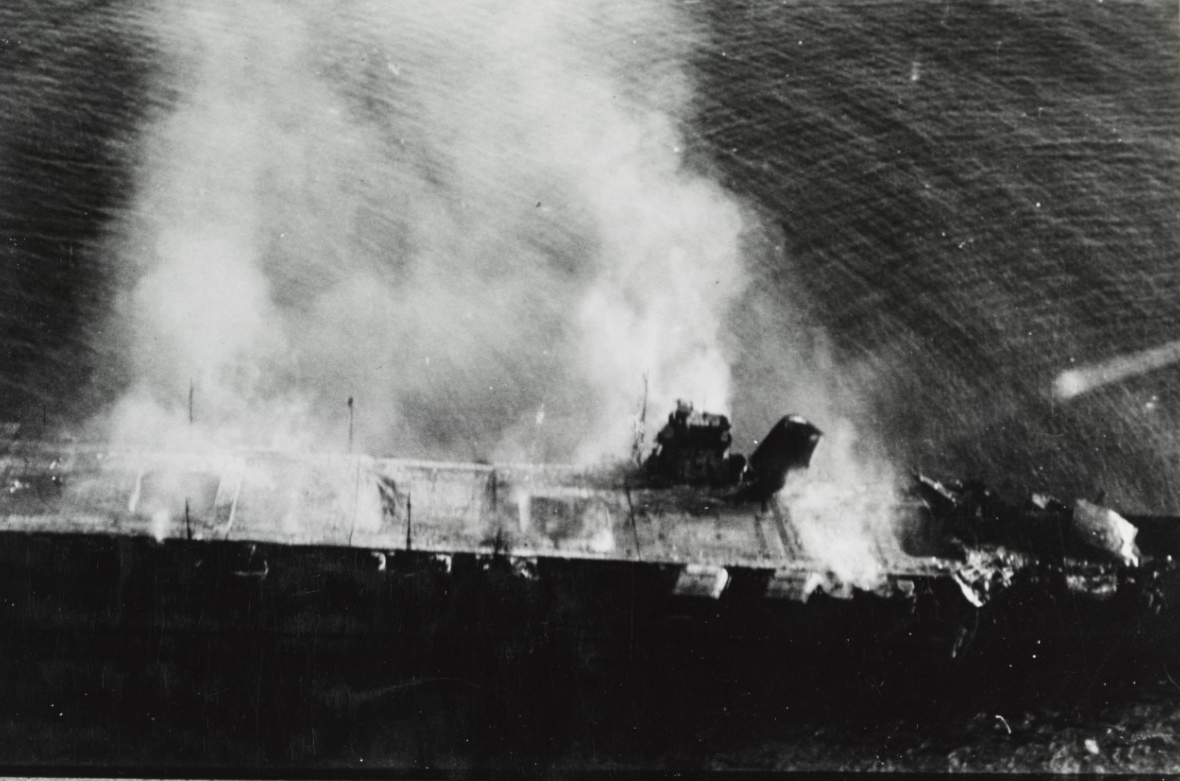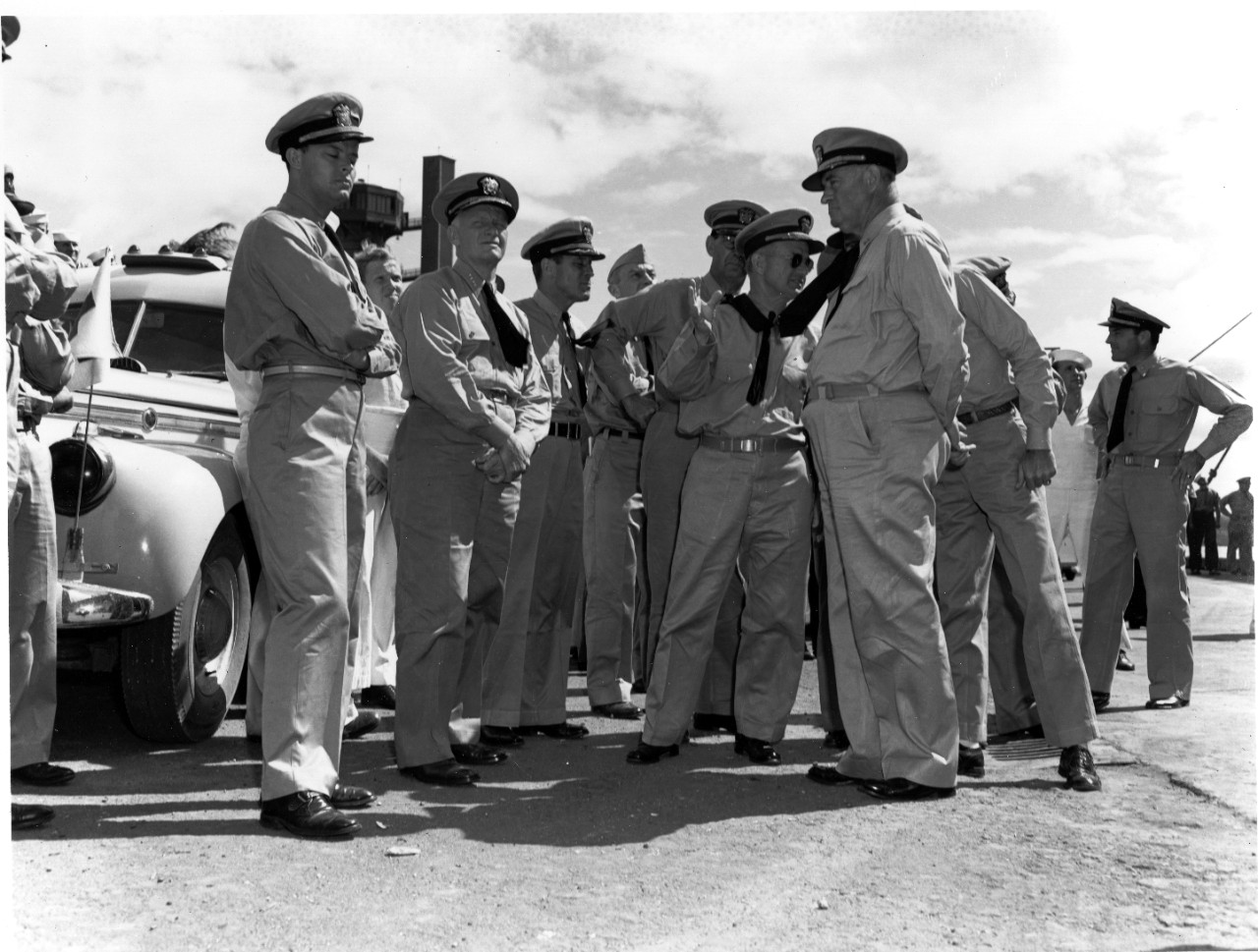Battle of Midway
4–7 June 1942
Torpedo Squadron SIX (VT-6) TBD-1 aircraft are prepared for launching on USS Enterprise (CV-6) at about 0730–0740, 4 June 1942. Eleven of the 14 TBDs launched from Enterprise are visible. Three more TBDs and ten F4F fighters must still be pushed into position before launching can begin. The TBD in the left front is Number 2 (Bureau No. 1512), flown by Ensign Severin L. Rombach and Aviation Radioman 2nd Class W. F. Glenn. Along with eight other VT-6 aircraft, this plane and its crew were lost attacking Japanese aircraft carriers somewhat more than two hours later. USS Pensacola (CA-24) is in the right distance and a destroyer is in plane guard position at left (80-G-41686).
The Navy will commemorate the Battle of Midway this year from 3 JUNE to 7 JUNE. Please use our Commemoration Toolkit for messaging, graphics and additional resources.
_____________________________________________________________________________
Overview
Strategic Background and the Role of Communications Intelligence
Following the outbreak of the Pacific War in December 1941, the Japanese armed forces conducted military operations against U.S., British Commonwealth, and Dutch possessions in the Pacific and Southeast Asia. The first phase of these operations, which was the seizure of Malaysia, Singapore, the Dutch East Indies, the Philippines, and various island groups in the central and western Pacific, was virtually complete by March 1942. The second phase, initiated by Japanese Imperial Headquarters on 23 January, was designed to isolate and neutralize Australia and India. In the Pacific, this plan envisioned the seizure of bases in Papua/New Guinea and the Solomon Islands, which would then be used to support future operations against New Caledonia, Fiji, and Samoa. By early March, with the seizure of Lae and Salamaua, the entire north coast of Papua/New Guinea had fallen to Japanese forces, who were planning for an amphibious invasion of Port Moresby.
At this time, two U.S. fleet radio-intercept units were in operation in the Pacific: one in Melbourne, Australia (FRUMEL—Fleet Radio Unit Melbourne), and another at Pearl Harbor ("Hypo" or FRUPAC—Fleet Radio Unit Pacific). A third (“Cast”), at Cavite and then Corregidor in the Philippines, was lost when U.S. forces there surrendered to the Japanese in 6 May. Fortunately, the station’s equipment could be destroyed and its cryptanalysts evacuated to Melbourne. These facilities intercepted Japanese radio communications and, through traffic analysis and codebreaking, uncovered the location of major fleet units and shore-based air forces. More important, by translating messages and studying operational patterns, Melbourne and Hypo were able to predict future Japanese operations with some degree of certainty. The intelligence centers provided their analysis, through daily COMINT briefings and warning reports, to senior American commanders, including Admiral Ernest J. King, commander in chief, U.S. Fleet, and Admiral Chester W. Nimitz, commander in chief, Pacific Fleet.
Following an American carrier raid on Japanese shipping at Lae and Salamaua on 10 March, which demonstrated to Admiral Shigeyoshi Inouye, commander in chief, Fourth Fleet, that Japanese were not assured of air superiority in the region, the Japanese decided to postpone their planned seizure of Port Moresby. It was not until early May, when Admiral Inouye had three carriers available, that the operation was initiated. On 7–8 May, the first carrier battle of the war took place in the Coral Sea. Each side suffered damage to a carrier, while the American lost the carrier USS Lexington (CV-3) and the Japanese lost the light carrier Shoho. More important, the Japanese broke off their invasion attempt. The Battle of the Coral Sea spelled the first setback for the Japanese since the beginning of the Pacific War. Significantly, American cryptanalysts had provided crucial Japanese order of battle and operational communications intelligence to the Allied commanders.
In addition to this advance toward Port Moresby, evidence that Japan was intent on expanding east of the Marshall Islands appeared in COMINT in early 1942. Indications of land-based air units and equipment began appearing in message traffic to and from the Marshall Islands and other Japanese-occupied Pacific territories. In March, the designator "AF" began appearing in partially decoded messages. Then, on 5 March, Japanese seaplanes, refueled from a submarine at French Frigate Shoals, Territory of Hawaii, conducted an armed reconnaissance mission over Oahu. Finally, on 13 March, American cryptanalysts both broke the Japanese navy's general-purpose code and tentatively identified "AF" as Midway.
On 16 April, after several months of discussion, Admiral Isoruku Yamamoto, commander in chief of the Combined Fleet, convinced the Imperial General Staff to agree to his risky Midway and Aleutians strategy. In Yamamoto's view, the capture of Midway would allow Japan to pursue its Asian policies behind an impregnable eastern shield of defenses in the Central Pacific. The centerpiece of this plan was a feint toward Alaska followed by the invasion of Midway. The U.S. Pacific Fleet was expected to respond to the landings on Midway. Japanese carrier and battleship task forces, waiting unseen to the west of the island, would fall upon and destroy the unsuspecting Americans. If successful, the plan would effectively eliminate the Pacific Fleet for at least a year and provide a forward outpost from which ample warning of any future threat by the United States would come. The U.S. Doolittle Raid, carried out on 18 April, served to reinforce Japan’s perceived need for an extended first line of defense and also to advance the date of the Midway operation. On 5 May, Imperial General Headquarters issued "Navy Order No. 18," which directed Yamamoto to carry out the occupation of Midway and key points in the western Aleutians in cooperation with the Imperial Japanese Army.
At the same time, Japanese Navy communication activity in the vicinity of Japan’s Home Islands dramatically increased, reflecting naval exercises conducted in preparation for both the Midway and Aleutian operations. On 7 May, Hypo provided a translation of the agenda for a Japanese aviation conference, which concerned tactics to be employed in obtaining air superiority over a target, assisting in amphibious landings, and bombing and strafing attacks to wipe out local resistance. On 9 May, Melbourne intercepted and translated "1st Air Fleet Striking Force Order No. 6," which confirmed the creation of a new carrier strike force and that a major fleet movement would begin on 21 May. In response to this COMINT, American cryptanalysts supplied warning notices of Japanese offensives scheduled for late May.
On 19 May, Commander Joseph J. Rochefort, officer in charge of COMINT processing at Hypo and Lieutenant Commander Edwin T. Layton, the Pacific Fleet staff intelligence officer, identified Midway and Dutch Harbor in the Aleutians as specific Japanese objectives. On 22 May, following a radio deception operation, Melbourne completely confirmed that "AF" indicated Midway. Hypo then discovered the date cipher used in Japanese message traffic. This meant analysts could determine exactly when the attack would take place. After examining previously intercepted messages, Hypo predicted an attack on Midway on 4 June. Admiral Nimitz used this estimate to plan American countermeasures that included reinforcement of the forces already on Midway.
On 26 May, the Japanese Northern Force, which included two light carriers, sailed from Japan toward the Aleutians. The next day, Japanese forces began getting underway for Midway. Chief among them was First Mobile Force/Carrier Strike Force, which comprised the four large carriers Akagi, Kaga, Soryu, and Hiryu with a total of 229 embarked aircraft. Two days later, the Japanese First Fleet/Main Body (Admiral Yamamoto in battleship Yamato) sortied from home waters. The Second Fleet/Escort Force, including 15 transports, sailed from Saipan; Second Fleet/Occupation Support Force sortied from Guam. These forces were supported by 17 patrol seaplanes.
Rear Admiral Raymond A. Spruance’s Task Force SIXTEEN (TF 16), formed around USS Enterprise (CV-6) and USS Hornet (CV-8), departed Pearl Harbor on 28 May to take up a position northeast of Midway. Two days later, Task Force SEVENTEEN (TF 17) under the command of Rear Admiral Frank Jack Fletcher, formed around USS Yorktown (CV-5), sailed from Pearl to join TF 16 northeast of Midway. When TF 17 and TF 16 joined about 350 miles northeast of Midway on 2 June, Fletcher became officer in tactical command. The three U.S. carriers, augmented by cruiser-launched floatplanes, provided 234 aircraft afloat. These were supported by 110 fighters, bombers, and patrol planes at Midway. As part of the pre-battle disposition, 25 U.S. fleet submarines were deployed around Midway.
Meanwhile, on 29 May, seaplane tender USS Thornton (AVD-11) arrived at French Frigate Shoals to relieve light minelayer USS Preble (DM-20) on patrol station there. The presence of U.S. ships prevented the Japanese from refueling flying boats to reconnoiter Pearl Harbor. Although the Japanese could not visually confirm the departure of Task Forces 16 and 17 from Pearl Harbor; American preparations to defend Midway were more apparent to the enemy. Japanese COMINT stations not only learned of carrier movements in and out of Pearl Harbor, simply by listening to increased air-ground radio chatter, but traffic analysis of "Urgent" radio messages coming out of Pearl Harbor suggested at least one U.S. Navy task force was at sea. Incredibly, this information was withheld from the Midway strike force because of Yamamoto's strict radio silence restrictions.
Scene on board USS Yorktown (CV-5), shortly after she was hit by three Japanese bombs on 4 June 1942. Dense smoke is from fires in her uptakes, caused by a bomb that punctured them and knocked out her boilers. Man with hammer at right is probably covering a bomb entry hole in the forward elevator. Note arresting gear cables and forward palisade elements on the flight deck; CXAM radar antenna, large national ensign, and YE homing beacon antenna atop the foremast; 5-inch/38-caliber, .50-caliber, and 1.1-inch guns manned and ready at left. Photo taken by Photographer 2rd Class William G. Roy from the starboard side of the flight deck, just in front of the forward 5/38 gun gallery (80-G-312018).
The Battle
On 3 June, in the preliminary moves of the Battle of Midway, American land-based aircraft from Midway located and attacked Japanese transports about 600 miles west of Midway Island. U.S. Army Air Forces Boeing B-17 Flying Fortresses inflicted no damage, however, and four Consolidated PBY Catalina patrol bombers were sent out from Midway for a night attack on the approaching landing forces. As part of the overall Japanese plan, planes from light carriers Ryujo and Junyo bombed Dutch Harbor.
Just after midnight on 4 June, Admiral Nimitz, based on patrol plane reports, advised Task Forces 16 and 17 of the course and speed of the Japanese "main body," also noting their distance of 574 miles from Midway. Shortly after dawn, a patrol plane spotted two Japanese carriers and their escorts, reporting "Many planes heading Midway from 320 degrees distant 150 miles!"
The first engagement on 4 June, however, took place when the four night-flying PBYs attacked the Japanese transports northwest of Midway, with one PBY torpedoing a fleet tanker. Later that morning, at roughly 0630, Japanese carrier aircraft bombed Midway installations. Although defending U.S. Marine Corps fighters suffered disastrous losses, the Japanese only inflicted slight damage to the island’s facilities on Midway.
Over the next two hours, Japanese fighter aircraft on combat air patrol (CAP) and antiaircraft fire from the Japanese fleet annihilated the repeated attacks by Midway-based Marine Corps scout bombers and Navy torpedo bombers. Army Air Forces heavy bombers and torpedo-carrying medium bombers likewise bombed the Japanese carrier force without success, although without losses to themselves.
Between 0930 and 1030, Douglas TBD Devastator torpedo bombers from the three American carriers attacked the Japanese carriers. Although nearly wiped out by the defending Japanese fighters and antiaircraft fire, they drew off enemy aircraft, leaving the skies open for dive bombers from Enterprise and Yorktown. Douglas SBD Dauntlesses from Enterprise bombed and fatally damaged carriers Kaga and Akagi, while SBDs from Yorktown bombed and wrecked carrier Soryu.
At 1100, Hiryu, the one Japanese carrier that escaped destruction that morning, launched dive bombers that temporarily disabled Yorktown around noon. Three and a half hours later, Hiryu's torpedo planes struck a second blow, forcing Yorktown's abandonment. In return, Dauntlesses from Enterprise mortally damaged Hiryu in a strike around 1700 that afternoon. The destruction of the Carrier Strike Force compelled Admiral Yamamoto to abandon his Midway invasion plans, and the Japanese fleet began to retire westward.
On 5 June, TF 16 under command of Rear Admiral Spruance pursued the Japanese fleet westward, while work continued to salvage the damaged Yorktown. Both Akagi and Hiryu, damaged the previous day, were scuttled by Japanese destroyers early that day.
The last air attacks of the battle took place on 6 June, when dive bombers from Enterprise and Hornet bombed and sank heavy cruiser Mikuma, and damaged destroyers Asashio and Arashio,,as well as the cruiser Mogami. At Spruance's express orders, issued because of the destruction of the three torpedo squadrons on 4 June, Enterprise Devastators that accompanied the strike did not attack because of the threat to them from surface antiaircraft fire. After recovering its aircraft, TF 16 turned eastward and broke off contact with the enemy. COMINT intercepts over the following two days documented the withdrawal of Japanese forces toward Saipan and the Home Islands.
Also on 6 June, Japanese submarine I-168 interrupted the U.S. salvage operations on Yorktown, torpedoing the carrier and torpedoing and sinking destroyer USS Hammann (DD-412). Screening destroyers depth-charged I-168, but the Japanese submarine escaped destruction. Yorktown finally rolled over and sank at dawn on 7 June.
Aftermath and Significance
Due to American COMINT capabilities, astute intelligence analysis, judicious aircraft carrier tactics, and more than a little luck, the U.S. Navy had inflicted a smashing defeat on the Imperial Japanese Navy. Although the performance of the three American carrier air groups would later be considered uneven, their pilots and crews had won the day through courage, determination, and heroic sacrifice. Against the loss of one U.S. carrier, the Japanese lost four—all of which had participated in the Pearl Harbor attack. More importantly, the Japanese lost over 100 trained pilots, who could not be replaced. In a larger strategic sense, the Japanese offensive in the Pacific was derailed and their plans to advance on New Caledonia, Fiji, and Samoa postponed. The balance of sea power in the Pacific had begun to shift.
Further Reading
Hone, Thomas C. The Battle of Midway: The Naval Institute Guide to the U.S. Navy's Greatest Victory. Annapolis, MD: Naval Institute Press, 2013.
Lundstrom, John B. The First Team: Pacific Naval Air Combat from Pearl Harbor to Midway. Annapolis, MD: Naval Institute Press, 2005.
Morison, Samuel Eliot. History of United States Naval Operations in World War II, Vol. IV: Coral Sea, Midway and Submarine Actions, May 1942–August 1942. Boston: Little, Brown and Company, 1950.
Japanese aircraft carrier Hiryu burning, shortly after sunrise on 5 June 1942, a few hours before she sank. Photographed by a plane from the carrier Hosho. Note collapsed flight deck at right. Part of the forward elevator is standing upright just in front of the island, where it had been thrown by an explosion in the hangar. SBD Dauntless dive bombers from USS Yorktown (CV-5) and USS Enterprise (CV-6) struck Hiryu during the late afternoon of 4 June. The Japanese scuttled the stricken carrier the following day (NH 74064).
U.S. and Japanese Forces at Midway
Battle of Midway, 3–6 June 1942: Composition of Japanese Naval Forces
The Japanese Story of the Battle of Midway, translation of captured Japanese documents by OPNAV P32-1002, Office of Naval Intelligence (ONI), June 1947
The Battle of Midway, formerly classified ONI combat narrative from March 1943. Republished in 2017 by NHHC with a new introduction. Also available as a PDF download (5.6 MB).
Midway: Sheer Luck or Better Doctrine, by Thomas Wildenburg, Naval War College Review, Vol. 58 (2005), No. 1
The Battle of Midway Including the Aleutian Phase, June 3 to June 14, 1942—Strategical and Tactical Analysis, by the U.S. Naval War College, 1948 (PDF download, 18.2 MB)
Battle of Midway: Interrogation of Japanese Officials (Vol. 1), by the U.S. Strategic Bombing Survey (Pacific), October 1945. Includes senior Japanese naval officers assigned to carriers Hiryu, Akagi, and Soryu at Midway.
Campaigns of the Pacific: The Battle of Midway—Japanese Plans, translation of captured Japanese documents by the U.S. Strategic Bombing Survey (Pacific), circa 1945
Battle of Midway, 4–7 June 1942: A Select Bibliography, by the U.S. Navy Library
NHHC publication: Winning a Future War—War Gaming and Victory in the Pacific War, by Norman Friedman. This acclaimed book shows how U.S. naval commanders successfully applied lessons learned from interwar war gaming to victorious carrier operations in World War II.
Battle of Midway Q & As, By Captain Henry Hendrix, Ph.D. and NHHC historian Robert Cressman, from The Sextant
The Role of Intelligence
The Role of COMINT in the Battle of Midway, by Henry F. Schorreck, former National Security Agency (NSA) historian
Midway in Retrospect, The Still Under-Appreciated Victory, by James R. Schlesinger, former Secretary of Defense
The Battle of Midway Still Teaches the Value of Intelligence, Decisive Action, by Rear Admiral Paul Becker, USN (ret.), from The Sextant
Navy Cryptology and the Battle of Midway: Our Finest Hour, by Lieutenant Commander Philip H. Jacobsen, USN (ret.), from The Sextant
Reflections on the Battle of Midway from the PACFLT Basement, by Captain Dale Rielage, USN, from The Sextant
Innovation and Victory at the Battle of Midway, by Admiral Scott Swift, Commander, U.S. Pacific Fleet, from The Sextant
Just-in-Time Production, Commander Matt Wright, USN (one of the winning essays from the 2022 CNO Essay Contest)
Tactical Lessons of Midway, by NHHC historian Robert J. Cressman
Midway’s Operational Lesson: The Need For More Carriers, by NHHC historian Robert J. Cressman
People
(Ranks and units/commands at the time of the Battle of Midway)
Battle of Midway Casualty List (508-compliant PDF, 120 KB), listing of U.S. personnel killed in action during the battle
Lieutenant Richard H. Best, squadron commander, Bombing Squadron SIX (VB-6), USS Enterprise (CV-6)
Rear Admiral Frank Jack Fletcher, commander, Task Force SEVENTEEN (TF 17)
Aviation Machinist's Mate 1st Class Bruno Gaido, SBD Dauntless gunner, Scouting Squadron SIX (VS-6), USS Enterprise (CV-6)
Ensign George Henry Gay, TBD Devastator pilot, Torpedo Squadron EIGHT (VT-8), USS Hornet (CV-8)
Vice Admiral William F. Halsey, commander, Task Force SIXTEEN (TF 16) during the Doolittle Raid, and commander, Carriers, Pacific Fleet
Commander Dixie Kiefer, executive officer, USS Yorktown (CV-5)
Chief Water Tender Charles Kleinsmith, engineering department, USS Yorktown (CV-5)
Lieutenant Commander Edwin T. Layton, U.S. Pacific Fleet N2, Pearl Harbor
Lieutenant Commander Maxwell F. Leslie, executive officer, Bombing Squadron THREE (VB-3), USS Yorktown (CV-5)
Lieutenant Commander Eugene E. Lindsey, commanding officer, Torpedo Squadron SIX (VT-6), USS Enterprise (CV-6)
Lieutenant Commander Lance E. Massey, commanding officer, Torpedo Squadron THREE (VT-3), USS Yorktown (CV-5)
Lieutenant Commander Clarence Wade McClusky, Jr., commander, Air Group SIX (CAG 6), USS Enterprise (CV-6)
Admiral Chester W. Nimitz, commander in chief, U.S. Pacific Fleet, and commander in chief, Pacific Ocean Area
Commander Joseph J. Rochefort, officer-in-charge, "Station Hypo," Pearl Harbor
Rear Admiral Raymond Ames Spruance, commander, Task Force SIXTEEN (TF 16)
Lieutenant Commander John S. Thach, commanding officer, Fighting Squadron THREE (VF-3), USS Yorktown (CV-5)
Lieutenant Commander John C. Waldron, commanding officer, Torpedo Squadron EIGHT (VT-8), USS Hornet (CV-8)
Remembering Midway, by Captain Roy P. Gee, USN (Ret.), from The Sextant
Ensign George H. Gay's Fateful Day, June 4, 1942, By Dr. Frank A. Blazich, Jr., Curator of Modern Military History, National Museum of American History, from The Sextant
Battle of Midway - Weisheit Oral Histories, oral histories conducted by Major Bowen P. Weisheit, USMCR (Ret.) with pilots who flew from USS Hornet (CV-8) at the Battle of Midway.
H-Grams
H-Gram 005-2: Carrier Versus Carrier (Us Versus Them)
H-Gram 006: 75th Anniversary of the Battle of Midway
H-Gram 035-1: Flight of the Avenger
H-Gram 072: The 80th Anniversary of the Battle of Midway
News Articles
SECNAV, CNO Host Battle of Midway Congressional Reception Event, by Mass Communication Specialist 2nd Class Jules Stobaugh, Defense Media Activity
World War II veteran presented Presidential Unit Citation, by Mass Communication Specialist 1st Class Abigayle Lutz
Digital Collections
Commemoration Resources
Midway Historical Overview Video
Battle of Midway Infographics
Admiral Chester W. Nimitz, Pacific Fleet commander in chief (second from left), pierside at Pearl Harbor, 8 June 1942, watching USS Fulton (AS-11) arrive. She was carrying survivors of USS Yorktown (CV-5), sunk in the Battle of Midway on 4 June. Rear Admiral William L. Calhoun, Pacific Fleet Service Force commander, is in the right center, wearing sunglasses. Rear Admiral Lloyd J. Wiltse, of Nimitz's staff, is in the center background (80-G-312025).






